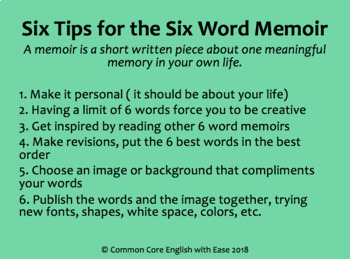


4, March 2008, with the issue theme “Teaching Spelling and Vocabulary in High School.” Additional teacher information on synonyms and language can be found in a variety of articles from English Journal, Vol. Familiarize yourself with the ideas of synonyms, connotation, register, and sound/rhythm.Photocopy the Choosing the Best Word: Six-Word Memoirs handout for students.If computer accessibility is a problem, print out paper copies of the interactive and make enough copies for each student. You will need computers with internet access for each student to use this interactive. Test the Word Matrix student interactive.“Six Tips for Writing Six-Word Memoirs”.Preview the following videos and decide which you will show and/or are appropriate for your students:.You may wish to choose a few memoirs to share with and/or point out to the students. Familiarize yourself with the content within the book(s). Locate one or more copies of the Six-Word Memoir books.Students use spoken, written, and visual language to accomplish their own purposes (e.g., for learning, enjoyment, persuasion, and the exchange of information). Students participate as knowledgeable, reflective, creative, and critical members of a variety of literacy communities.ġ2. Students develop an understanding of and respect for diversity in language use, patterns, and dialects across cultures, ethnic groups, geographic regions, and social roles.ġ1. Students use a variety of technological and information resources (e.g., libraries, databases, computer networks, video) to gather and synthesize information and to create and communicate knowledge.ĩ. Students employ a wide range of strategies as they write and use different writing process elements appropriately to communicate with different audiences for a variety of purposes.Ĩ. Students adjust their use of spoken, written, and visual language (e.g., conventions, style, vocabulary) to communicate effectively with a variety of audiences and for different purposes.ĥ. They draw on their prior experience, their interactions with other readers and writers, their knowledge of word meaning and of other texts, their word identification strategies, and their understanding of textual features (e.g., sound-letter correspondence, sentence structure, context, graphics).Ĥ. Students apply a wide range of strategies to comprehend, interpret, evaluate, and appreciate texts. Students read a wide range of literature from many periods in many genres to build an understanding of the many dimensions (e.g., philosophical, ethical, aesthetic) of human experience.ģ. Among these texts are fiction and nonfiction, classic and contemporary works.Ģ.

Students read a wide range of print and nonprint texts to build an understanding of texts, of themselves, and of the cultures of the United States and the world to acquire new information to respond to the needs and demands of society and the workplace and for personal fulfillment.


 0 kommentar(er)
0 kommentar(er)
